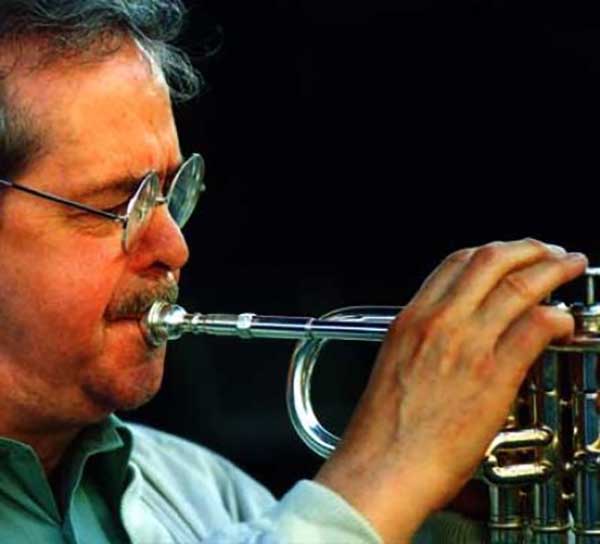
by Tim Owen
January 07, 2009
/ LIVE
Wheeler's music is mature, sophisticated and utterly unique. A packed house enjoyed a rare treat.
Kenny Wheeler’s back catalogue is of the richest in Jazz, and the way in which his latest band work through it in their live shows invites comparison with another quintet: that once led by Miles Davis at the Plugged Nickel. Davis and Wheeler are alike in having refined distinct compositional methodologies, in writing for key collaborators with whom they innovate collectively, and in renewing the jazz tradition by recasting well-known standards. Both favour the quintet format, and their quintets have established distinct and highly aestheticised branches of the jazz tradition. Davis’ innovations may have been the more revolutionary, but Wheeler’s songbook is equally strong, and draws more heavily on his own compositions. His current working band is on consistently stunning form.
Returning to the Vortex for the second two-night stand of the year, Wheeler begins tonight’s first set with two of his best known tunes, the original Kind Folks and the standard By Myself. Kind Folks may be best known from Angel Song, but this quintet version is busier and more exploratory. Drummer Martin France and Bassist Chris Lawrence immediately establish themselves as a well-matched team, both urgent and probing, but it’s Stan Sulzmann who initially dominates By Myself (again, quite unlike the reading given on Music For Large and Small Ensembles), prompting Wheeler to respond boldly; his bleary elisions contrasting well with Sulzmann’s directness.
The following reassembly of Jigsaw, which both Sulzmann and Wheeler have recorded independently, illustrates the strength and flexibility of Wheeler’s compositions. Kenny Wheeler’s tone here contrasts nicely with his playing on the previous tune: here his tone is bright and clear. The rhythm is fast and nimble, and Sulzmann’s switch to soprano sax complements Wheeler appropriately. Sulzmann solos urgently, while Parricelli deploys reverb and delay effects. Wheeler’s turn, by contrast, is implacably measured and deliberate. Wheeler is particularly adept at finding unexpected angles in this way, subtly wrong-stepping expectation.
For most of the night, Wheeler maintains a customarily hangdog expression, but he introduces the next number, perhaps to savour one of his own uniquely punning song titles. Imminent Immigrant features a mournful trumpet solo over hard swinging drums and a driving bass line. Wheeler sounds like he is harmonizing with himself. It’s a fine illustration both of the strength and tensility of Wheeler’s melodies, and of the precision of Wheeler’s judgements in modulation, stress and pitch.
Blues For CM may be best known from the repertoire of Dave Holland’s Big Band, but tonight’s outing reminds us of its first showing by a Wheeler quintet back in 1987, on Razors Edge. Parricelli channels some of the tension generated during Imminent Immigrant to launch the number with a relatively aggressive solo, before gradually yielding to the slow blues theme; that tension then slowly coils tighter and palpably spreads to the audience.
The second set opens gently, with the Tango-esque Sly Eyes, and a long Parricelli intro to a lovely, dynamically rich rendition of Billy Strayhorn’s A Flower Is A Lovesome Thing. This pairing establishes a mood of elegant chamber jazz, epitomising the face of Kenny Wheeler with which listeners to his recordings may be most familiar; a mood which is rudely interrupted by the aggressive drumming that heralds the next number.
Noah is perhaps Parricelli’s strongest contribution to the bands repertoire, and his style here bears comparison to that of Bill Frisell circa Lookout For Hope. His layering of loops over Lawrence’s arco bass creates a sound mass that demands a strong unison theme from the horns and a forceful trumpet solo. With France’s drumming increasingly agitated, the horns bow out and a second Parricelli solo takes us fully into ‘power trio’ territory. Somehow all this resolves to a semi-abstract passage by a Sulzmann trio, with the rhythm section taking the tempo down a notch or two. This sets the scene for a serene Kenny Wheeler solo. The roller coaster ride then concludes with an easy swinging coda. The set-closing number, Where Do We Go From Here, brings us back to earth.
Before leaving the stage, Sulzmann comments on Wheeler’s exceptionally fine current form, adding a testimonial to the pleasure he derives from their playing together. Wheeler gives him an arch look that salts faux surprise with raised eyebrows. Wheeler’s modest stance and low public profile tend to obscure his true standing as one of the giants of the music. His music is mature, sophisticated, and utterly unique. Perhaps to him it seems routinely so, but for the packed house tonight it’s a rare treat.
blog comments powered by Disqus